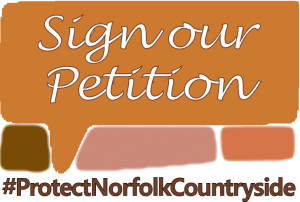Housing & Development
CPRE Norfolk is campaigning against unprecedented growth in the county which has been proposed and supported by local planning authorities. Sign up to support our campaign HERE .
We recognise the need for new housing in the area but have grave concerns over the impact of current ambitious housing targets on the character of the countryside. Tranquillity will be lost, light pollution will increase, traffic levels will escalate, and the rural nature of this part of Norfolk will be severely diminished.
All of Norfolk’s District and Borough Councils have to increase housing in their areas, with by far the greatest growth being proposed in the Norwich area. The Greater Norwich Development Partnership (GNDP) consisting of Broadland and South Norfolk District Councils, Norwich City Council and Norfolk County Council has produced Local Plans which aim to deliver some 72,000 new houses over the period 2001-2036. Whilst much new housing is needed, this is only the case if it is of the right type in the right location, in particular through providing the right quantity of affordable homes. Moreover, new sites for housing in existing Local Plans are not being built at the required rate, so CPRE Norfolk is urging that phasing is adopted, whereby existing allocations are built-out before any new sites are considered for development.
We are campaigning to reduce the housing targets across Norfolk in an Alliance on Housing with local community groups concerned about the impact on their communities.
Download our Statement on plans for excessive housing in Norfolk.
CPRE Norfolk is campaigning against a new garden settlement between Billingford, Bintree and North Elmham. Our views are explained in this letter to Breckland District Council’s Leader, William Nunn.
Affordable Housing – what is it?
Affordable Housing is used widely and with various definitions, which adds to the confusion surrounding the crucial provision of housing for those in need of housing to buy or rent below the market price.
In November 2017 a House of Commons Briefing Paper was published titled what is affordable housing? This included a summary of statements and policies on the issue, including this from December 2015 when the Government suggested that affordable Starter Homes would be sold at a minimum discount of 20% off the market price subject to price caps of £250,000 outside London and £450,000 within London. However, many questioned just how affordable such prices would be. A fairly straightforward and practical definition provided by the Government in 2016, although one that is still very broad, states that for a property to be considered affordable, the mortgage payments on a house should be more than that paid in rent on council housing, but still be below market levels. The rent on an affordable home should cost no more than 80% of the average local market rent.
A more detailed definition for planning purposes is given in the National Planning Policy Framework (NPPF). It reads from the Glossary:
‘Affordable housing: Social rented, affordable rented and intermediate housing, provided to eligible households whose needs are not met by the market. Eligibility is determined with regard to local incomes and local house prices. Affordable housing should include provisions to remain at an affordable price for future eligible households or for the subsidy to be recycled for alternative affordable housing provision.
Social rented housing is owned by local authorities and private registered providers (as defined in section 80 of the Housing and Regeneration Act 2008), for which guideline target rents are determined through the national rent regime. It may also be owned by other persons and provided under equivalent rental arrangements to the above, as agreed with the local authority or with the Homes and Communities Agency.
Affordable rented housing is let by local authorities or private registered providers of social housing to households who are eligible for social rented housing. Affordable Rent is subject to rent controls that require a rent of no more than 80% of the local market rent (including service charges, where applicable).
Intermediate housing is homes for sale and rent provided at a cost above social rent, but below market levels subject to the criteria in the Affordable Housing definition above. These can include shared equity (shared ownership and equity loans), other low-cost homes for sale and intermediate rent, but not affordable rented housing.
Homes that do not meet the above definition of affordable housing, such as “low cost market” housing, may not be considered as affordable housing for planning purposes.’ (page 50, NPPF, March 2012.)
Looking at the cost of housing as a percentage of monthly income, the housing charity Shelter suggests that affordable housing to rent or buy should cost no more than 35% of your net monthly income after tax and benefits, whilst acknowledging that this could still be difficult for those on very low incomes to pay.
This is similar to the common-sense approach suggested by CPRE Norfolk. Put simply this means the affordable definition should be that the cost of the property, whether rented or purchased, would enable the homeowner or tenant to be able to afford the property including running costs and still live within their means with the opportunity to save something.


